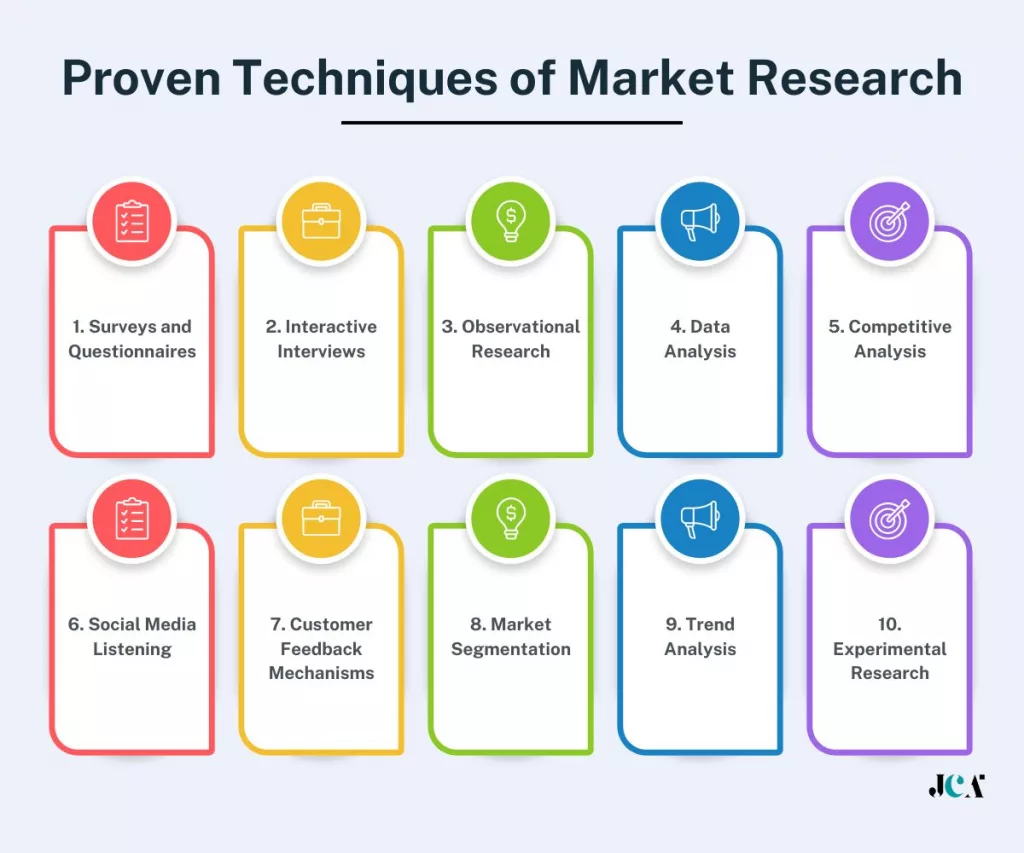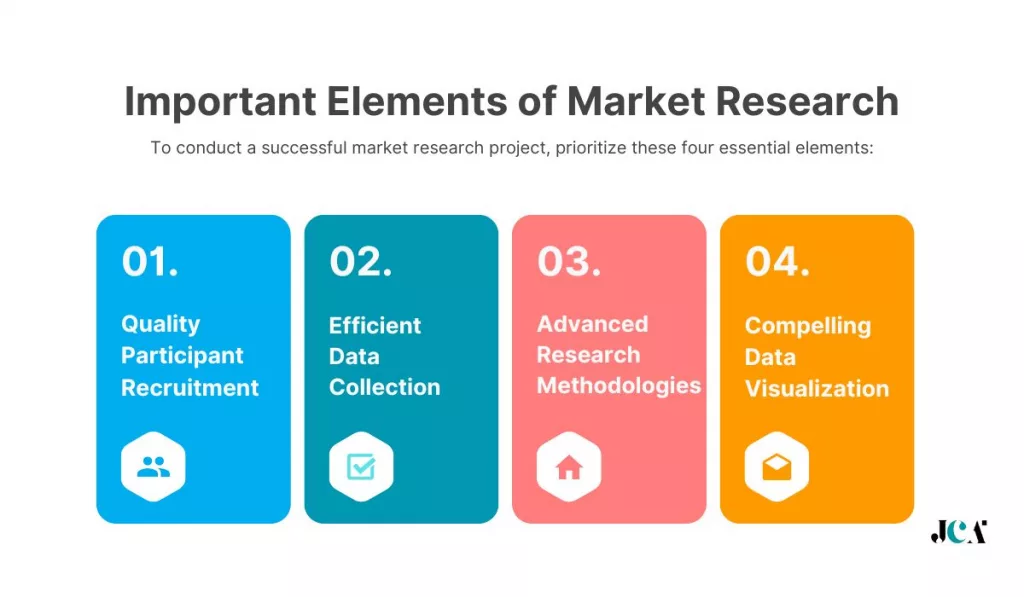Market research lays the foundation for a successful business. Its vitality and capacity to understand customer needs, intent, pain points, and preferences are the reason. Every entrepreneur requires these details, which guide him to make informed decisions.
These decisions can be introducing new products, sustaining & growing a business, enhancing quality, expanding the customer base, establishing competitive pricing, etc. Overall, market research techniques are associated with decisions and strategies. They guide what to decide and how to achieve any business objective.
This post will help you figure out different techniques of market discovery. So, let’s move on to explore them.
What is Market Research?
Market research is a systematic process to gather information about target markets and customers.
It involves collecting, analyzing, and interpreting data regarding the market. These include consumer preferences, purchasing behaviour, competition, and market trends. This process helps businesses make informed decisions about product development, pricing, promotion, and distribution strategies.
Market research can be conducted through various methods, including surveys, interviews, focus groups, and analysis of existing data, to better understand customer needs and market opportunities.
Let’s understand market techniques in detail.
Proven Techniques of Market Research

There are multiple techniques, but the most common and proven are given below.
1. Surveys and Questionnaires

Surveys and questionnaires are popular for collecting the intents of the target audience. However, it is like asking questions and receiving answers through a questionnaire. It helps in extracting a sample of individuals’ intentions from the target audience. This can be done effectively by designing an online survey clearly and concisely.
It consists of relevant questions relating to the existing and prospective product or service. It can be conducted through multiple mediums, such as online forms, phone interviews, or face-to-face interviews/interactions.
Many organizations understand the significance and results of these market research services and techniques. So, they invest in tools like SurveyMonkey, Google Forms, etc. to create actionable insights from the target audience.
2. Interactive Interviews

Interviews are one-on-ones that help in gaining in-depth insights into target groups or individuals’ preferences and opinions. These interviews are slightly different from surveys. However, this method also involves multiple questions like surveys. However, they involve open-ended discussions, which provide qualitative datasets. Commercial entities can prefer interviews, focus group discussions, or expert discussions that resonate with research objectives.
For this purpose, interviewing techniques should be sharp. It involves probing and active listening to extract meaningful insights from participants. These days, some advanced technologies have evolved, such as video conferencing via Zoom and Microsoft Meet, to remove the barrier of distance.
Check this blog out: Defining Your Unique Selling Proposition: How to Stand Out in a Crowded Market.
3. Observational Research

The technique is another interesting way of gathering desirable datasets. As its name suggests, observational research refers to closely observing and recording the way consumers behave in the real-time market. This technique particularly reveals how customers interact with specific products or services in a real-life environment.
This research technique can be used in different forms. These can be mystery shopping, ethnographic studies, and eye-tracking experiments. With these methods in place, entrepreneurs find ways to discover valuable information regarding customers’ purchasing patterns, their behaviour, pain points, pricing etc.
Consider the setting of a retail business. This research technique proves helpful in discreetly observing the journey of web shoppers, how they interact with products, and how they reach to purchasing decisions. The researchers continue to notice the dwell times at certain product pages and discover their behaviour through clicks to know their interest, and patterns to purchase. These observations inform retailers to optimise their retail store layouts online and redefine their product placements, and marketing strategies to meet their customer needs and trigger overwhelming sales.
4. Data Analysis

This is the world of digitisation, where big data is vast and continues to get vaster. Put simply, businesses have electronic devices and applications that allow data to continuously flow in. This vast amount of quantitative information can have vital details that can transform your business and revenues. This can happen by analysing them to derive meaningful insights. Data analysis is a technical technique involving the deep analysis of regression, clusters, and trends.
The result of this analysis helps in determining the patterns, correlations, and trends within the target market. This method can be applied to sales, marketing, and website data. With it, businesses can discover the crystal-clear picture of sales, marketing strategies, website traffic, social media engagement, and customer demographics. These all details help in understanding customer intent, behaviour, and market trends.
Fortunately, there are AI-powered tools like Tableau, SAP, and even Microsoft Excel have some advanced features that make it easy to discover insights into whatever the entrepreneur likes to know.
5. Competitive Analysis

Competitive analysis refers to the insights-driven knowledge of the competitors in the market. This type of analysis is essential to research where your business stands. This research technique targets competitors’ data, which can include, but may not be limited to, their products, pricing strategies, marketing strategies, and customer satisfaction levels.
This type of research aims at understanding the strengths, weaknesses, opportunities, and threats in the market from the competitors. It helps in auditing their dynamics and highlights the areas where they can have competitive advantages. This is how businesses can foresee opportunities by introducing something innovative. It can also be the thing that customers intend to have.
For instance, an e-commerce company can discover the pricing strategies, offerings, and customer support practices of its competitors. These discoveries help in defining promotional campaigns and offering discounts so that the company can lead the competition. Moreover, the insights of their customers and product reviews guide them to discover opportunities, as they include their likelihoods, pains, confusions, etc. Overall, this kind of research technique helps in winning a cutting edge in a competitive market.
Also read: Ways to Use ChatGPT to Market Your Small Business.
6. Social Media Listening

The popularity of social media platforms is worthy. Their insights into customer’s intent, behaviour, preferences, etc. become discoverable through thorough monitoring and analysis. The researchers collect online conversations from the customers’ chats. In addition, close monitoring informs about the customers’ comments and sentiments relating to a brand, product or industry. Besides, some advanced analytics tools are available to use natural language processing and sentiment analysis algorithms. Their deep auditing introduces them to a large volume of data. With it, businesses derive opportunities to identify prospective trends, customers’ emotions, and their feedback in real-time.
Let’s consider the example of a skincare product-selling company’s social media account. Its deep monitoring on Twitter and Instagram reveals the statistics of its mentions and comments. These figures and insights into the effectiveness of the product and packaging help the brand to improve and introduce a new skincare product range to win their satisfaction and loyalty.
Related: Maximizing Customer Engagement through Social Media: Best Practices
7. Customer Feedback Mechanisms

Customer feedback reveals real insights into the quality and customer experience. This is why companies research feedback by integrating multiple customised channels or methods, which can be a CSAT form, suggestion box, or online review (like Google). These methods help in continuously exploring the intent of customers directly from them.
Additionally, businesses can leverage Net Promoter Score (NPS) survey forms so that it becomes effortless to measure the satisfaction and loyalty of customers. An understanding of their expectations and pain points guides you to deliver proper responses, showing your commitment to customers. This response can also be an offer or solution to fix their problems, which wins their satisfaction.
8. Market Segmentation

Market segmentation research is an age-old technique that divides the market based on demographic, psychographic, and behavioural characteristics. These categories make it easy to customise their marketing strategies according to their segments.
Based on clusters and other factors, businesses create similar groups. These groups have customers with similar factors like needs and preferences. This is how they can target market segments by preparing and offering personalised marketing messages, product offerings and pricing strategies so that they can meet their expectations.
9. Trend Analysis

Market trends frequently change. This change can be related to customer preferences and market dynamics. Their historical data related to these change metrics consistently require proper monitoring so that patterns, cycles, and trends within the market can be discovered. Experienced researchers use techniques like time series and regression methods to foresee trends and make proactive decisions.
Apart from it, macroeconomic indicators like industry reports and consumer surveys can provide valuable insights into market trends and changes in customer behaviour.
An e-commerce merchant uses it to identify customer purchasing behaviour. It allows them to streamline inventory or stock management and marketing strategies. This analysis requires sales data from previous years, which helps in foreseeing an increase in demand for specific products during a specific period. It helps in anticipating their stock levels accordingly. This helps in meeting customers’ needs efficiently while minimising excess inventory costs.
10. Experimental Research

This research technique helps in designing controlled experiments that can help in testifying hypotheses. This research lets you find out the cause-and-effect relationships of the testing scenario. Many entrepreneurs use this technique to experiment with the impact of price changes, new features of the product, marketing campaigns and other factors that relate to consumer behaviour. These all are variables that can be changed or kept constant for a time being to observe their effects.
Researchers rigorously check these types of hypotheses to make some crucial decisions that can define the scalability and growth of a business.
What are the Important Elements of Market Research?
To conduct a successful market research project, prioritize these four essential elements:

1. High-Quality Participants
The foundation of insightful market research is a well-selected sample of participants. Quality matters more than quantity; participants should be carefully chosen for their relevance to your target market and their ability to provide thoughtful, actionable feedback.
For broader insights, a sample reflective of the general population may suffice. However, for niche markets, consider partnering with panel providers who can offer access to specific demographic groups. Whether you’re conducting quantitative or qualitative research, ensuring high-quality responses is critical for generating reliable insights that accurately represent your customer base.
2. Efficient Data Collection
Opt for a research approach that enables swift and efficient data gathering. The speed of data collection can significantly impact your ability to act on emerging market trends. Utilizing an online research platform can offer real-time insights, allowing for immediate analysis and faster decision-making compared to traditional research methods.
This efficiency is crucial in a fast-moving market, enabling you to stay ahead of competitors by quickly responding to consumer preferences and trends.
3. Advanced Methodologies
Elevate your research by implementing advanced techniques for a deeper understanding of your target market. Beyond basic questions, explore methods like the Price Sensitivity Meter or MaxDiff analysis to gain nuanced insights into pricing strategies or product preferences.
These advanced methodologies can provide detailed information that is crucial for product development, pricing strategies, and marketing efforts, offering a competitive edge in understanding and meeting customer needs.
4. Data Visualization
Presenting research findings in an engaging and accessible way is key to ensuring they are understood and acted upon by stakeholders. Invest in data visualization tools that go beyond basic charts to include dynamic, interactive elements like dashboards, statistical testing, and customized visuals. Effective data presentation can significantly enhance the impact of your research, making it easier for decision-makers to grasp complex insights and use them to inform business strategies.
By focusing on these four elements—quality participant recruitment, efficient data collection, advanced research methodologies, and compelling data visualization—you can ensure your market research efforts are both impactful and actionable, driving informed decisions that contribute to business success.
Also check: Top 20 AI Tools for Small Businesses 2025: Expert Selected Tools for Business Growth
Wrapping Up
Market research is a broad concept, which has multiple techniques involved to gather relevant datasets. These details help achieve the objectives that are predefined for the research. Accordingly, the experts employ the best-fit technique, which can be a combination of more than one method.
As aforementioned there are interviews, surveys, data analytics, and observational research-like techniques that have been proving milestones for businesses that are looking for innovative and transformative changes in their business, profitability, and scalability. In this fast-paced and highly competitive corporate environment, random decisions won’t be helpful. There is a need to make informed decision, which has fresh and relevant data as its base. It can help in understanding the voice of data and then, deriving patterns to make decisions.










Leave a Reply